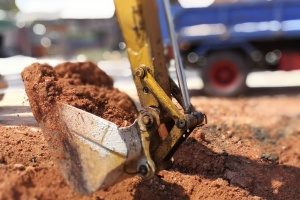There is Dirt, and There is Other Dirt: Fill Dirt Described
 Whatever dirt you use, it needs to consist of the materials best suited for its intended purpose. For example, you would use garden soil and topsoil in your yard and gardens. It contains organic material that provides a nutrient-rich environment for growing plants. But for building a home or a road bed, you cannot use topsoil because the organic materials will decompose and the surface will sink. Topsoil will not support building structures and will erode quickly. For construction projects, you must use rockier, heavier, inorganic dirt. This type of dirt is called fill dirt.
Whatever dirt you use, it needs to consist of the materials best suited for its intended purpose. For example, you would use garden soil and topsoil in your yard and gardens. It contains organic material that provides a nutrient-rich environment for growing plants. But for building a home or a road bed, you cannot use topsoil because the organic materials will decompose and the surface will sink. Topsoil will not support building structures and will erode quickly. For construction projects, you must use rockier, heavier, inorganic dirt. This type of dirt is called fill dirt.
Fill dirt, or simply “fill”, is used to fill holes or build up ground elevation on construction sites. Fill dirt is usually made of subsoil, which is a found about 12 inches below the topsoil. It consists of partially broken down soil that contains clay, sand, silt, and stones, and any other materials found in the source ground. If the fill dirt comes from the subsurface of old farm fields or from woodlands, it will contain whatever materials are there. It may contain some organic material, but it is mostly inorganic. Its inorganic qualities make it ideal as fill because it does not decompose and settle like organic soil is prone to do. Fill dirt is usually less expensive than other types of dirt.
You can get fill dirt screened or unscreened. When screened, it will have the larger rocks and materials screened out and removed.
Do not mistake fill dirt for fill sand. Both can be used to fill low areas, but they have significantly different properties. Fill sand is made of fine particles of rock that have been broken down and eroded over many years. It is good for improving drainage around wet areas and to fill areas around septic tanks and ponds where drainage is important. Sand tends to be prone to shifting and displacement, while dirt is not. Fill sand is best used in projects that will involve regular exposure to water and moisture, while fill dirt is the best option for other project types.
Five Best Ways to Use Fill Dirt
 The best uses for fill dirt are in areas that will not support plant materials. A soil engineer will provide an analysis of your project and the specifications of the dirt that is suitable for your project according to applicable building codes. Depending on your project, you may need several layers of different kinds of dirt to provide a stable base of support. Here are five of the most common uses for common fill dirt:
The best uses for fill dirt are in areas that will not support plant materials. A soil engineer will provide an analysis of your project and the specifications of the dirt that is suitable for your project according to applicable building codes. Depending on your project, you may need several layers of different kinds of dirt to provide a stable base of support. Here are five of the most common uses for common fill dirt:
1. Site preparation and base for a home, other building structure, or sidewalk. A home, building, road, or sidewalk needs a solid, stable base of support. For this purpose, you need to use fill dirt that has been screened and determined free of organic material, which is suitable. It should be used on the project surface area to smooth it over and fill in any holes or low spots that may have been created when clearing the ground in preparation for building.
2. Raise the ground to create mounds. Fill dirt is ideal for changing the elevations on your property. With fill dirt, you can build raised planting beds, embankments, mounds, or terracing. Because it packs well and does not decompose, it can form a good base for raised areas or fill in low spots. In some communities, mounds and embankments create sight barriers that improve privacy. These mounds can then be topped off with nutrient-rich top soil for plants, or hardscape structures such as patios and sidewalks.
3. Correct poor drainage near your foundation or other areas on your property. Fill dirt is excellent material to use to correct poor drainage and eliminate water seeping through your foundation or flowing into your home. Proper drainage means that the ground slopes away from your home in all directions, dropping at least two inches every ten feet. The angle of slope 10 feet from the house should never be less than a 6-inch drop.
4. Support for a retaining wall. Use fill dirt to backfill and support the uphill side of a retaining wall. It provides a great brace to keep the wall sound for many years.
5. Support for an inground pool. When you excavate to construct an inground pool, your pool removal contractor will use fill dirt to provide solid, even support for the pool and to level off the area around it.
For more information about your needs, contact a reputable fill dirt provider. It is important that you get the correct type of dirt. Using the wrong dirt can be a very costly mistake and cause significant delays in your project. The fill dirt provider can present you with information about the type of dirt that you need for your particular project and related pricing.











































